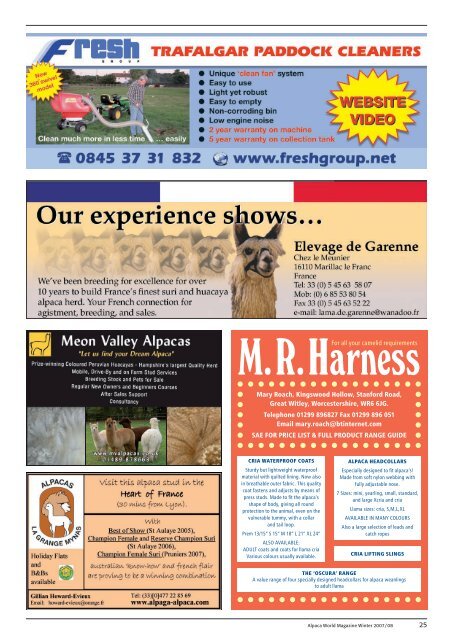Winter - Classical MileEnd Alpacas
Winter - Classical MileEnd Alpacas
Winter - Classical MileEnd Alpacas
You also want an ePaper? Increase the reach of your titles
YUMPU automatically turns print PDFs into web optimized ePapers that Google loves.
Unless you can move sideways and keep<br />
your alpaca from running past you the space<br />
is too wide- a space such as a barn aisle way or<br />
pasture lane way no more than15 feet wide by<br />
30-40 feet long is ideal. In order to be useful,<br />
your leading space must be directly adjacent<br />
to the area that you use for halter training.<br />
Once your alpaca has gone on a few walks,<br />
has negotiated a few easy obstacles and is<br />
responding to a signal to stop consistently you<br />
are ready to teach your alpaca to tie.<br />
The first several tying lessons should happen<br />
inside an enclosed area. Panic reactions are<br />
much less likely in an enclosed space and<br />
if they do occur they are usually much less<br />
violent. Using a 11-15 foot long smooth flat<br />
lead line attach your lead rope to the halter<br />
and run it around a smooth pole using one<br />
wrap and hold the end of the line in your hand.<br />
Make sure that the line can slide freely around<br />
or cane to tap the rear legs of the alpaca when<br />
he pulls back to help him understand that he<br />
should come forward. Once your alpaca learns<br />
to come forward and accept the restriction of<br />
being tied you can tie him to the rail using a<br />
quick release knot (see sidebar??). Make sure<br />
to stay alert and be ready to pull on the release<br />
end of the lead rope if your alpaca really begins<br />
to lay back on the rope.<br />
In my opinion it is not a good idea to tie an<br />
alpaca without being close at hand. There are<br />
also times when alpacas should not be tied.<br />
Never tie an alpaca in a trailer unless you<br />
can continually monitor the animal.<br />
Avoid tying your alpaca when you introduce<br />
new things. It is much better to work in a<br />
catch pen when teaching your alpaca to accept<br />
new and potentially scary equipment.<br />
When you do use a chute always use one<br />
with a back gate or barrier. Tie the alpaca with<br />
into your tying system is a good safety measure<br />
if you must leave your alpaca alone even for a<br />
short period of time. I would much rather cope<br />
with a loose alpaca than one that is injured.<br />
The fight response is a powerful instinctive<br />
response. Take the ability to run away from<br />
an alpaca and he moves to the fight response<br />
or freeze response sometimes moving rapidly<br />
between the two. Animals that are in the<br />
midst of a panic response have a very hard<br />
time processing information just as we<br />
humans have a hard time learning when<br />
we are frightened. Tying an alpaca without<br />
teaching him to accept the process first is not<br />
an efficient way to educate him and can be<br />
dangerous. Work with your alpacas in a way<br />
that honours their nature and capitalises on<br />
their considerable intelligence and you will be<br />
rewarded with an alpaca that truly enjoys his<br />
association with humans.<br />
38 Alpaca World Magazine Summer 2007<br />
Mary Roach, Kingswood Hollow, Stanford Road,<br />
Great Witley, Worcestershire, WR6 6JG.<br />
Telephone 01299 896827 Fax 01299 896 051<br />
Email mary.roach@btinternet.com<br />
SaE FoR pRicE liST & Full pRoducT RanGE GuidE<br />
CRIA WATeRPROOF COATS<br />
Sturdy but lightweight waterproof<br />
material with quilted lining. Now also<br />
in breathable outer fabric. This quality<br />
coat fastens and adjusts by means of<br />
press studs. Made to fit the alpaca’s<br />
shape of body, giving all round<br />
protection to the animal, even on the<br />
vulnerable tummy, with a collar<br />
and tail loop.<br />
Prem 13/15” S 15” M 18” L 21” XL 24”<br />
ALSO AVAILABLE:<br />
ADULT coats and coats for llama cria<br />
Various colours usually available.<br />
ALPACA heADCOLLARS<br />
Especially designed to fit alpaca’s!<br />
Made from soft nylon webbing with<br />
fully adjustable nose.<br />
7 Sizes: mini, yearling, small, standard,<br />
and large Xcria and cria<br />
Llama sizes: cria, S,M,L,XL<br />
AVAILABLE IN MANY COLOURS<br />
Also a large selection of leads and<br />
catch ropes<br />
CRIA LIFTIng SLIngS<br />
The ‘OSCURA’ RAnge<br />
A value range of four specially designed headcollars for alpaca weanlings<br />
to adult llama<br />
Alpaca World Magazine <strong>Winter</strong> 2007 / 08<br />
25







